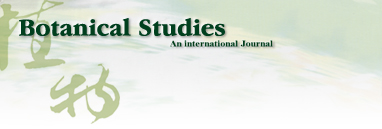 |
|
|
| TITLE | Seed germination eco-physiology of Mikania micrantha H.B.K |
| AUTHOR | Qi-He YANG South China Botanical Garden, the Chinese Academy of Sciences, Guangzhou 510650, The People's Republic of China Qi-He YANG South China Botanical Garden, the Chinese Academy of Sciences, Guangzhou 510650, The People's Republic of China Wan-Hui YE South China Botanical Garden, the Chinese Academy of Sciences, Guangzhou 510650, The People's Republic of China Xiong DENG South China Botanical Garden, the Chinese Academy of Sciences, Guangzhou 510650, The People's Republic of China Hong-Ling CAO South China Botanical Garden, the Chinese Academy of Sciences, Guangzhou 510650, The People's Republic of China Yun ZHANG South China Botanical Garden, the Chinese Academy of Sciences, Guangzhou 510650, The People's Republic of China Kai-Yang XU South China Botanical Garden, the Chinese Academy of Sciences, Guangzhou 510650, The People's Republic of China |
| FULL TEXT | [in HTML format] [in PDF format] |
| ABSTRACT | Mikania micrantha H.B.K is an invasive alien weed in South China. To help understand the mechanisms of its invasiveness, we studied its seed germination ecophysiology. We found that the optimal temperatures for seed germination were 25, 30, 15/30°C (night/day), and an ambient temperature (24-32°C). Germination percentage (GP) in dark was less than 10%, and it increased with increasing light intensity up to 700 lx. However, GP and germination index (GI) did not change significantly when light was more than 700 and 550 lx, respectively. Germination was enhanced by white, yellow and red light more than far-red, blue, and green light. Light sensitivity and germination of seeds increased with increasing dark incubation time. Newly ripened seeds exhibited innate dormancy that was released by a two-month after-ripening period in dry storage. Except at a storage temperature of -5°C, seed GP decreased when storage time exceeded the after-ripening period, and this decrease was more pronounced from a storage temperature of 4°C to 15°C to ambient 24-32°C. Percentage seedling emergence was lower and slower when seeds were covered deeper in soil, and no emergence occurred when seeds were buried at 1.5 and 1.75 cm in clayey and sandy soil, respectively. With increased soil moisture content (MC) from 8% to about 20%, seedling emergence became increased and quickened. However, an MC greater than 23% reduced emergence. These responses of seed germination to various treatments indicate that this weed is well adapted to environments in South China. |
| KEYWORD | Germination; Light; Mikania micrantha, Seed; Soil depth; Soil moisture; Soil type; Temperature; |
| ARTICLE INFO | Botanical Bulletin of Academia Sinica, Volume 46 Number 4 October 2005, page 293-299, 7 pages |
| PUBLISHER | Institute of Plant and Microbial Biology, Academia Sinica, Taipei, Taiwan, Republic of China |
